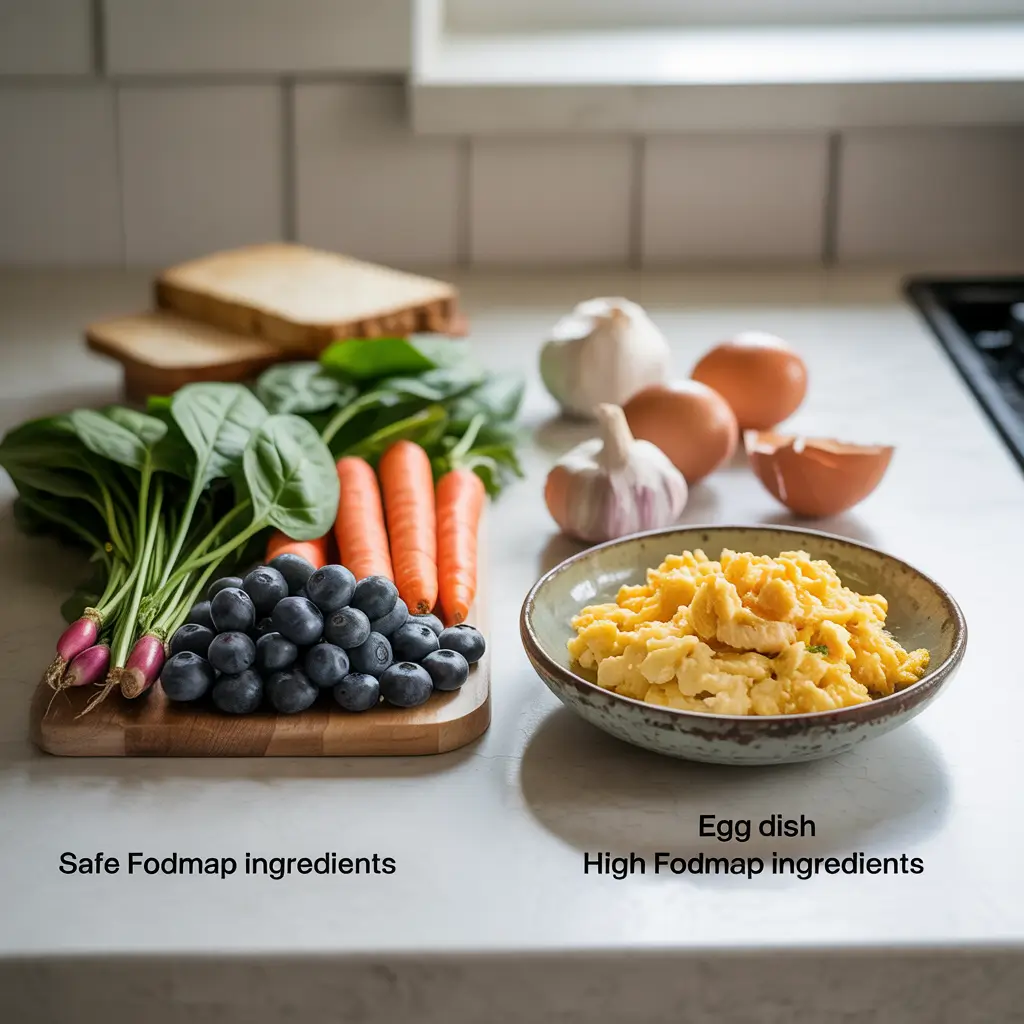Low FODMAP Diet Eggs – Everything You Need to Know About Gut-Friendly Egg Consumption
Low FODMAP diet eggs are a safe and simple protein source for anyone managing IBS or digestive discomfort. Since eggs contain no fermentable carbs, they fit perfectly into a low FODMAP lifestyle—when cooked and paired wisely.
In this guide, you’ll learn how eggs impact gut health, how many you can eat, which cooking methods are safest, and which common add-ons to avoid. We’ll also cover tasty low FODMAP egg recipes and tips for long-term success.
Don’t miss our complete guide on low FODMAP diet foods – the complete 2025 guide to gut-friendly eating to build your meal plan with confidence.
PrintLow FODMAP Diet Eggs – Everything You Need to Know About Gut-Friendly Egg Consumption
A gut-friendly guide to enjoying eggs on a low FODMAP diet. Eggs are naturally FODMAP-free and versatile—perfect for IBS-friendly meals when cooked and paired properly.
- Prep Time: 5 minutes
- Cook Time: 5 minutes
- Total Time: 10 minutes
- Yield: 1 serving 1x
- Category: Breakfast
- Method: Stovetop
- Cuisine: Low FODMAP
Ingredients
- 2 large eggs
- 1/2 cup fresh spinach (low FODMAP)
- 1 tablespoon chives or green tops of scallions
- 1 teaspoon olive oil (FODMAP-safe)
- Salt and pepper to taste
Instructions
- Heat olive oil in a nonstick pan over medium heat.
- Add spinach and chives, sauté for 1–2 minutes until wilted.
- Crack eggs into a bowl, beat lightly, and pour over the vegetables.
- Scramble gently until cooked through, about 2–3 minutes.
- Season with salt and pepper. Serve hot with gluten-free or low FODMAP toast if desired.
Notes
Eggs are FODMAP-free and safe in moderation. Avoid high FODMAP ingredients like onions or garlic. Use lactose-free cheese or FODMAP-safe herbs to customize.
Nutrition
- Serving Size: 1 plate
- Calories: 220
- Sugar: 1g
- Sodium: 180mg
- Fat: 16g
- Saturated Fat: 4g
- Unsaturated Fat: 11g
- Trans Fat: 0g
- Carbohydrates: 2g
- Fiber: 1g
- Protein: 14g
- Cholesterol: 370mg
Keywords: low FODMAP eggs, IBS-friendly breakfast, gut-friendly eggs, scrambled eggs, FODMAP-free
Understanding the Low FODMAP diet eggs
What is the Low FODMAP diet eggs and Why Is It Popular?
The Low FODMAP diet eggs is a structured eating plan designed to reduce digestive discomfort caused by fermentable carbohydrates. FODMAPs—an acronym for Fermentable Oligosaccharides, Disaccharides, Monosaccharides, and Polyols—are short-chain carbs that are poorly absorbed in the gut and can trigger bloating, gas, abdominal pain, and irregular bowel movements in sensitive individuals, especially those with IBS.
This gut-focused diet works in three phases: elimination, reintroduction, and maintenance. First, high-FODMAP foods are removed. Then, each group is reintroduced one at a time to monitor symptoms. Lastly, a personalized, gut-friendly eating plan is created.
Thanks to research-backed success, the low FODMAP diet has become a go-to for managing IBS symptoms and other functional gut disorders. In fact, many individuals report noticeable improvements within just a few weeks of starting the elimination phase.
How the Diet Affects Digestive Health and IBS Symptoms
By reducing fermentable compounds, the low FODMAP diet can help calm the gut and reduce inflammation. This allows the digestive system to rest, reset, and better tolerate certain foods over time.
Eggs—especially low FODMAP diet eggs—are often recommended during this process because they are naturally FODMAP-free, gentle on digestion, and rich in nutrients. Including gut-friendly proteins like eggs can support overall health without worsening IBS.
Want more IBS-safe foods? Check out this helpful list on low FODMAP diet nuts – the complete 2025 guide to gut-friendly snacking.
Are Eggs Low FODMAP Friendly?

Nutritional Breakdown of Eggs and FODMAP Classification
When it comes to protein options for sensitive stomachs, low FODMAP diet eggs top the list. Eggs are a complete protein, containing all nine essential amino acids, plus vital nutrients like vitamin D, choline, and B12. Most importantly, eggs contain no fermentable carbs, which means they do not fall into any FODMAP category.
Unlike dairy or wheat-based products that often cause flare-ups, eggs are naturally FODMAP-free. That makes them an excellent choice during both the elimination and reintroduction phases of the diet. You don’t need to worry about portion size when it comes to FODMAP content—whether it’s one egg or three, the carbohydrate content remains negligible.
Why Eggs Are Considered Low FODMAP
Eggs are classified as low FODMAP by Monash University, the research team behind the diet itself. Since eggs don’t contain lactose, fructose, or fiber, they pass through the digestive system without triggering the gut fermentation that causes symptoms like bloating and cramping.
However, it’s not just the eggs themselves that matter—it’s also what you pair with them. Additives like garlic powder, onions, or high-FODMAP bread can turn a safe food into a trigger.
To stay on track, start your morning with a simple boiled egg or scrambled egg with spinach. Learn more about low FODMAP diet chocolate – the complete 2025 guide for IBS-safe sweetness to enjoy a gut-friendly treat later in the day.
How Many Eggs Can You Eat on a Low FODMAP Diet?
FODMAP Serving Sizes and Egg Consumption
Unlike many foods on the low FODMAP plan, eggs don’t have a serving size limit based on FODMAP content. That’s because eggs are naturally free of fermentable carbohydrates, which are the compounds responsible for triggering digestive issues in sensitive individuals.
So how many eggs can you eat on a low FODMAP diet? Technically, as many as your body can tolerate. One to two eggs per meal is common for most people, but some may be comfortable eating more depending on personal digestion, dietary needs, and cooking method.
However, quantity is only part of the equation. When you overdo any protein—even FODMAP-free ones like eggs—it may cause digestive discomfort for reasons unrelated to FODMAPs, such as fat content or bile response. Therefore, moderation is still wise.
How to Monitor Tolerance and Avoid Overconsumption
To figure out your ideal egg intake, start slowly. Try one hard-boiled or poached egg and track your symptoms. As long as everything feels right, you can slowly start increasing the amount you consume. Pay attention to how your body responds over 24 hours, especially if you have a sensitive stomach.
Also, avoid adding high-FODMAP ingredients like onion, garlic, or creamy sauces that might confuse your results. Keeping a food journal can help identify whether low FODMAP diet eggs are truly well-tolerated or if other factors are at play.
Different Egg Preparations and FODMAP Impact
Boiled, Scrambled, and Fried Eggs – Are They Safe?
The way you prepare low FODMAP diet eggs can impact how well your digestive system tolerates them. While eggs themselves are FODMAP-free, their cooking method and added ingredients can make a big difference.
Boiled eggs—whether hard or soft—are among the safest options. They’re cooked without oil, dairy, or seasonings, making them ideal during the elimination phase of a low FODMAP plan.
Scrambled eggs are also typically well-tolerated, but it’s important to use lactose-free milk or water instead of regular dairy milk, which is high in FODMAPs. Stick to low-FODMAP add-ins like chives, spinach, or cheddar (if it’s lactose-free).
Fried eggs are still low FODMAP—as long as they’re cooked in suitable oils. Avoid butter (which contains lactose) or garlic-infused oils unless they’re FODMAP-safe (like garlic-infused oil made without particles).
Cooking Oils, Spices, and Add-ons That Trigger FODMAP
Many people unknowingly sabotage their IBS-safe eggs by cooking them with high FODMAP ingredients like onions, garlic, leeks, or sour cream. Even small amounts of these can trigger bloating or cramping.
To keep your meal gut-friendly:
- Use FODMAP-safe oils (like olive or avocado oil).
- Season with herbs (parsley, basil) instead of onion or garlic.
- Pair with low FODMAP veggies or gluten-free toast.
FODMAP-friendly cooking matters just as much as the ingredient itself.
Do Eggs Affect IBS Symptoms?
The Science Behind Eggs and IBS Flare-Ups
Although low FODMAP diet eggs are free from fermentable carbs, they can still cause digestive issues in certain individuals with IBS—but not because of FODMAPs. Instead, symptoms may be tied to fat content, cooking style, or underlying food sensitivities.
Eggs are a rich protein and fat source, which can stimulate gastrocolic reflex—a natural reaction that speeds up bowel movements after eating. In sensitive guts, this response can be exaggerated, leading to cramps or diarrhea. This is especially true with fried or heavily seasoned eggs.
However, for most people, eggs are completely IBS-safe when eaten in moderation and prepared properly. They offer essential nutrients like vitamin B12, selenium, and healthy fats without irritating the digestive tract.
Best Practices for Including Eggs Without IBS Issues
To reduce the risk of flare-ups, choose simple egg preparations—like boiled, poached, or dry-scrambled using olive oil. Avoid pairing eggs with known IBS triggers like onions, garlic, or rich dairy sauces.
Eating eggs with low FODMAP fiber sources, such as spinach or quinoa, can help balance the digestive impact. Keep servings moderate and eat slowly to reduce gut stress.
If you’re unsure whether eggs are your trigger, try an elimination and reintroduction approach—common in FODMAP plans—to isolate the effect.
Remember, the goal is to enjoy gut-friendly meals that support—not stress—your digestive system.
High FODMAP Foods to Avoid with Eggs

What Not to Eat with Eggs on a Low FODMAP Plan
Even though low FODMAP diet eggs are inherently gut-friendly, combining them with the wrong ingredients can quickly make your meal high FODMAP—and trigger IBS symptoms. It’s not always the egg itself, but the common pairings that cause trouble.
Let’s start with breakfast. A typical egg dish often includes toast, cheese, onions, or sauces—all of which may be high in FODMAPs. For example, regular wheat bread contains fructans, a major FODMAP group. Unless you’re using certified low FODMAP bread, it’s best avoided.
Other high FODMAP foods to skip when cooking with eggs:
- Garlic and onions (especially in omelets or scrambles)
- Dairy milk or cream (used in scrambled or baked eggs)
- Mushrooms like portobello or button (polyol content)
- Avocados (only 1/8 avocado is considered low FODMAP)
- Processed meats like sausages with high-FODMAP fillers
Common Recipe Combinations That Can Trigger Symptoms
Watch out for meals like:
- Fried eggs with garlic-infused butter
- Quiche made with onions and milk
- Egg salad with honey mustard or regular mayo
Instead, keep your low FODMAP diet eggs clean and simple. Pair them with spinach, zucchini, or tomatoes (all low FODMAP) and cook with olive oil or lactose-free butter. Stick to low-FODMAP seasonings like paprika, chives, or fresh herbs.
Clean combinations can help you enjoy eggs while minimizing digestive risk.
Egg Recipes for a Low FODMAP Diet
Gut-Friendly Breakfast Ideas with Eggs
When it comes to breakfast on a low FODMAP plan, low FODMAP diet eggs are incredibly versatile and satisfying. Since they’re naturally FODMAP-free, they’re the perfect base for a variety of dishes that won’t upset your gut.
Here are a few simple, IBS-friendly breakfast options:
- Spinach and chive omelet: Use two eggs, a handful of baby spinach, and fresh chives sautéed in garlic-infused oil.
- Soft-boiled eggs with gluten-free toast: Choose a certified low FODMAP bread and serve with sliced cucumber or cherry tomatoes.
- Scrambled eggs with zucchini and cheddar: Opt for lactose-free cheese and pan-fry thin zucchini slices before adding eggs.
These meals are quick, low in fermentable carbs, and easy on the digestive system—ideal for starting the day without discomfort.
Easy Low FODMAP Lunch & Dinner Recipes with Eggs
Don’t limit low FODMAP diet eggs to just breakfast. They’re excellent in lunch and dinner recipes, too. For example:
- Egg and quinoa salad: Toss chopped boiled eggs with cooked quinoa, spinach, olive oil, and lemon juice.
- Frittata with bell peppers and herbs: Use red bell peppers, lactose-free cheese, and bake for an easy, make-ahead dinner.
- Poached egg on sautéed kale and rice: A nourishing, well-balanced, and filling option.
Egg-based meals are not only FODMAP-safe, they’re budget-friendly and high in protein—making them ideal for long-term gut health. “Looking for visual inspiration? Explore gut-safe recipe boards on Pinterest curated for the low FODMAP lifestyle.”
Tips for Buying and Cooking Low FODMAP Eggs
Choosing Organic, Free-Range, or Omega-3 Enriched Eggs
When shopping for eggs, it’s not just about whether they’re low FODMAP—it’s about quality. The good news is that low FODMAP diet eggs include all types of eggs, regardless of brand or production style. However, choosing higher-quality options can enhance digestion and overall health.
Organic eggs are laid by hens that are raised on a completely natural diet, free from antibiotics, synthetic additives, or growth hormones.Free-range eggs mean the hens had access to outdoor space, which may improve the nutritional profile of the eggs. Omega-3 enriched eggs are another smart pick, offering added anti-inflammatory benefits that can support gut health.
While FODMAP content doesn’t change between egg types, people with IBS may find that higher-quality eggs are easier on the stomach and offer better taste and nutrition.
Safe Cooking Tips for Sensitive Stomachs
How you cook eggs matters just as much as the type. Stick to gentle cooking methods like:
- Boiling
- Poaching
- Dry scrambling (with olive oil)
Avoid heavy butter, rich cream, or frying in high-FODMAP oils. Also, steer clear of processed seasonings or pre-packaged mixes, which may contain onion or garlic powder.
To get the most out of your low FODMAP diet eggs, keep things simple. A clean pan, minimal ingredients, and gut-safe sides go a long way in preventing IBS symptoms and supporting digestive comfort.
Long-Term Egg Consumption on a Low FODMAP Diet

Maintaining Gut Balance and Nutrient Intake
While low FODMAP diet eggs are safe and nutritious, eating any food repeatedly without variety can impact your overall nutrition. Eggs are rich in protein, choline, and essential B vitamins, but they lack fiber and phytonutrients found in plant-based foods.
To maintain long-term gut health, pair eggs with low FODMAP veggies like spinach, zucchini, or red bell peppers. Rotate your egg-based meals with other gut-safe proteins like firm tofu, chicken breast, or canned tuna in spring water. The key is diversity—supporting both digestion and nutrient balance.
If you’re relying on eggs for breakfast daily, try switching up the preparation (scrambled one day, boiled the next) and adding different FODMAP-friendly sides to avoid meal fatigue.
Egg Rotation Strategies for Balanced Nutrition
Even with low FODMAP diet eggs, variety is your best friend. Use them 4–5 times a week instead of daily, and mix in other IBS-friendly meals to broaden your diet. Consider using eggs in recipes like frittatas or grain bowls, where you can sneak in more low FODMAP veggies, herbs, and healthy fats.
Paying close attention to how your body reacts over time is essential for long-term success. If you notice symptoms despite clean eating, it may be time to reassess frequency or preparation. But when used mindfully, eggs remain a reliable, gut-friendly staple in any long-term FODMAP plan.
FAQ: Low FODMAP Diet Eggs
How many eggs can you eat on a low FODMAP diet?
Eggs don’t contain FODMAPs, so there’s no strict limit. Most people can enjoy 1–3 eggs per meal without issues. Always test your own tolerance.
What are the worst foods for FODMAP?
Some of the top triggers include garlic, onions, wheat, apples, and milk. These ferment in the gut and often cause bloating or IBS flare-ups.
Do eggs affect IBS?
Eggs are FODMAP-free, but some people with IBS react to the fat or how they’re cooked. Keep it simple—boiled or scrambled in olive oil is best.
Is a fried egg low in FODMAP?
Yes, as long as you use FODMAP-safe oils like olive oil. Skip garlic butter or onions. Clean, simple prep makes low FODMAP diet eggs easy to tolerate.
For more ideas, check out our guide on low FODMAP diet chocolate – the complete 2025 guide for IBS-safe sweetness.“For more FODMAP tips and gut-friendly ideas, follow us on Facebook for daily meal inspiration.”



1 thought on “Low FODMAP Diet Eggs – Everything You Need to Know About Gut-Friendly Egg Consumption”
Comments are closed.